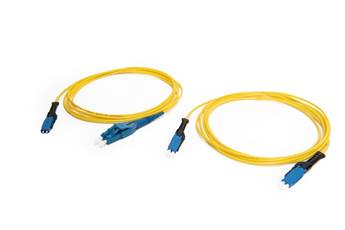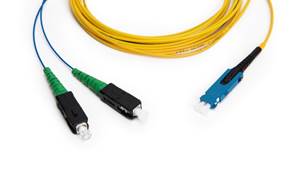By: Cindy Ryborz, Marketing Manager – DC (EMEA), Corning Optical Communications.
The data centre industry is experiencing unprecedented growth and innovation as new players, new business models and new technologies converge. Despite a slowdown in 2020, Gartner projects that spending on global data centre infrastructure will reach $200 billion in 2021 and grow year-on-year through 2024.
Driving this growth is a need to support ever more rapid and seamless transition of data, with technologies like 5G, and the applications it supports, requiring huge volumes of data to be processed, analysed and stored. This will see a need to not only invest in faster transceiver technology, future-ready physical infrastructure, cabling and connectivity but also simplify network architectures which have become more and more complex over time.
Fibre optic connectors will play an important role in this transition and the past few decades have seen the arrival of a diverse range of connector types, some developed to support the scalability of data centres as they have grown to reach 40G and 100G. From the range of connectors released to the market within the last 30 years, there are two interfaces, the LC duplex and MPO/MTP which have made their way into the standards for data centres.
However, what is fit for purpose today can quickly change as the industry moves forward and new architectures emerge. As data centre operators search for modern ways to achieve faster, greater, and more powerful data rates like 400G, we they must look at even higher density connectivity and ways to simplify network design with breakout options.
Beyond the readily available form factors, the market is meeting this need by introducing new connectors categorised as ‘Very Small Form Factor Connectors’ (VSFFC) such as the Senko Nano (SN) and US Conec Mini-Duplex Connector (MDC). As of yet, equipment manufacturers have not released transceivers for these connector interfaces, but they are expected to announce their availability within the next couple of years.
What does this mean for your data centre?
From tenants in colocation data centres that pay by space, to users that are reaching capacity in their own facilities, achieving greater density and preparing for future requirements is increasingly key. Even though today you may not need to implement 400G in your data centre increasing density in the main distribution area (MDA) is always valuable and future demands from new applications or services may consume the bandwidth available to date
MDC and SN connector formats promise the possibility of connecting directly from one high-speed transceiver to another transceiver, which simplifies the insertion of individual connectors into various switches from 400G to 4x100G. In addition, up to three MDC or SN connectors fit into the footprint of an LC duplex, which provides an enormous density advantage.
For operators struggling with reduced space in their data centre, implementing LC Duplex connectivity with LC to MDC patchcords and compatible hardware is an effective approach. This will not only allow the LC Duplex footprint to be retained at the transceiver end but the port density with MDC in modules or cassettes of the same size can also be increased by up to 3x – imagine the possibility of having 432 instead of 144 fibres in one rack-unit.
VSFFCs also help to lower the total cost of ownership. Various optical component manufacturers are already starting to offer solutions with these connectors, but it is important to find the best cabling infrastructure solution that also allows for continued use or reuse of existing components. This in turn helps to minimise the initial investment while meeting future scalability requirements.
Beyond the SN and MDC, the CS Corning-Senko Duplex (CS) represents another option in the VSFF space. It’s important to note that, while the three types all contain two fibres, they have many differences in design and functionality – including size as well as the vertical/horizontal orientation of the fibre. The SN and MDC can also be ganged together as a 4×2 fibre connector, which the CS cannot do. Given these variances, the CS, MDC and SN receptacles are not compatible and this therefore has an effect on the optical transceiver socket that will be needed and also the passive connectivity components.
Moving beyond pluggable optics
The future of this industry will see a variety of technological advances that will help us achieve higher data rates – from 40G to 100G to 400G all the way up to 1.6T.
The use of pluggable optics may play an important role up to 800G and it is to be expected that certain future developments will use some of the form factors already mentioned. However, for 1.6T, the high density and power consumption requirements means that pluggable optics might not be the best solution.
When it comes to these higher data rates, there is another way, namely the co-packaged solution. Here, data transmission and data processing are coupled in semiconductor components, as Intel demonstrated, for example, with a recently published co-packaged Ethernet switch. By doing this, co-packaged optics promise to increase density, reduce latency, reduce the power consumption and reduce the size of the switches.
Reaching these data rates will mean going above and beyond the current small form factor connectors previously mentioned. Further developments can be expected in the expanded beam area, resulting in more applications with connectors such as the US Conec MXC connector or the 3M EBO. New developments in fibre such as multicore fibre (MCF) and reduced cladding fibre will also have a tangible impact on further connector developments.
Preparation is key
The perennial challenge for data centre operators is to ensure that the networking and structured cabling design remains flexible to minimise cabling infrastructure costs when the time to upgrade to higher networking speeds like 400G and beyond arrives.
Careful planning and preparation will avoid costly upgrades and changes in footprint further down the line, with increasingly compact connectors and fibre management a vital component to building 400G networks that can serve high volume telecommunications providers, enterprises and hyperscale data centres.
About the Author:
Cindy is marketing expert in Data Centre. She holds a Master of Arts degree from Humboldt University in Berlin, Germany.
Starting her career in Corning Optical Communications with the customer care group in 2008 she has worked with customers in different regions to develop long-standing mutual relationships and to provide the highest quality of service and support day to day and project demands in today’s challenging environments.
Joining marketing in June 2012 she took on the execution of Corning’s Local Area Networks strategy across the EMEA region working closely with distribution channels and loyalty program members to support with marketing efforts and technical expertise before moving into the strategic Marketing Manager role for IBN/LAN in 2016 and DC Marketing Manager in the Regional Marketing Team in 2018.






